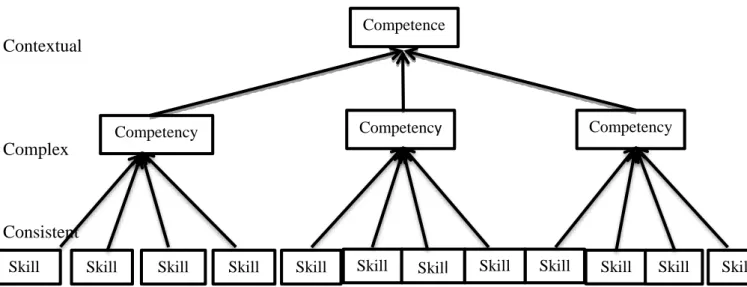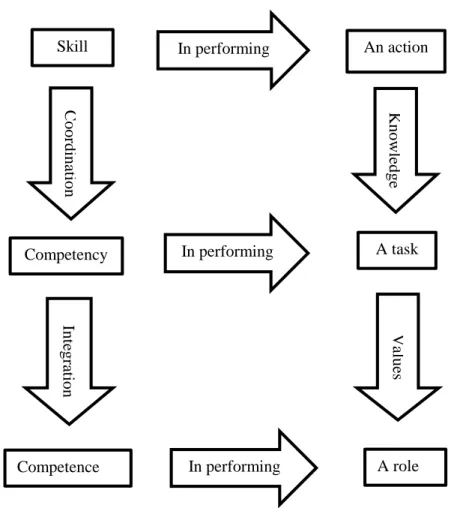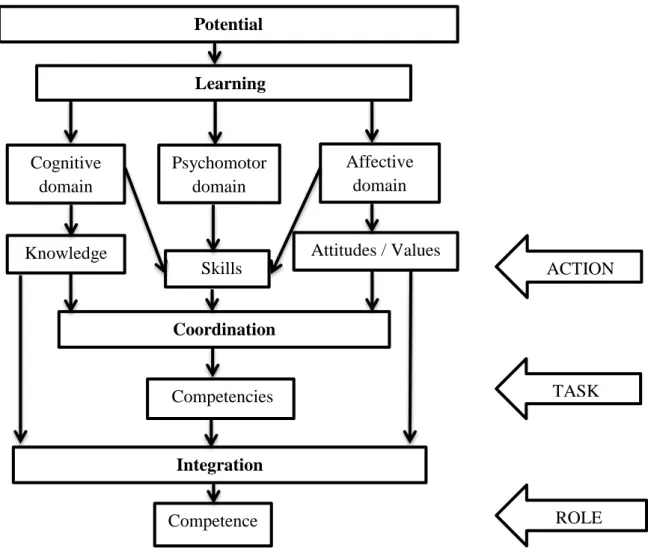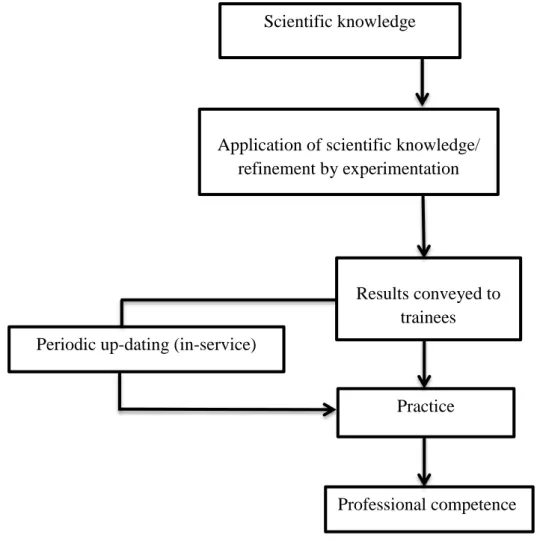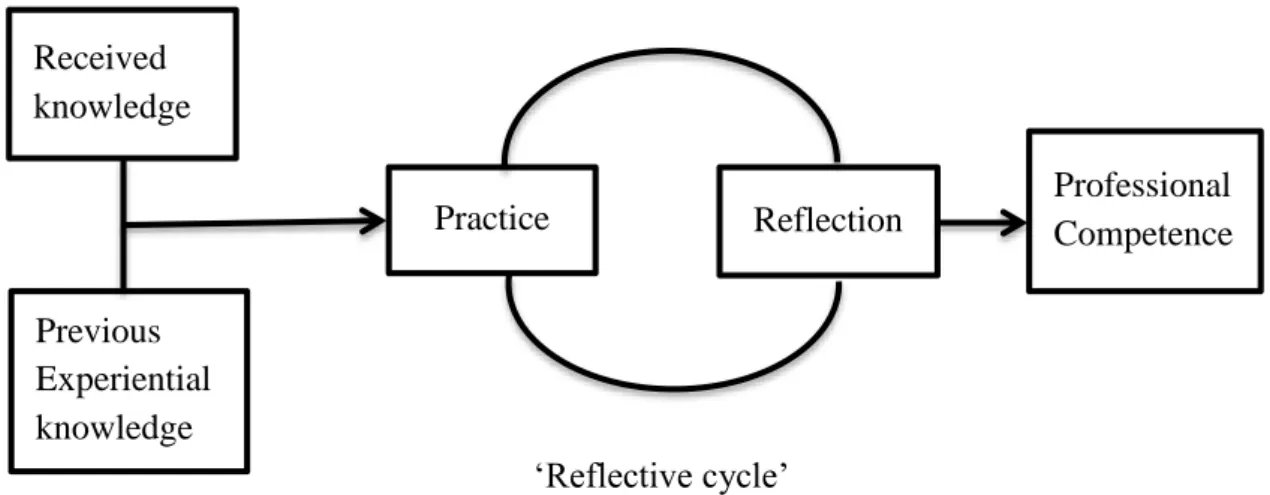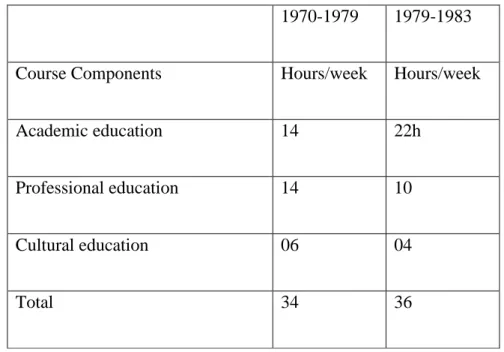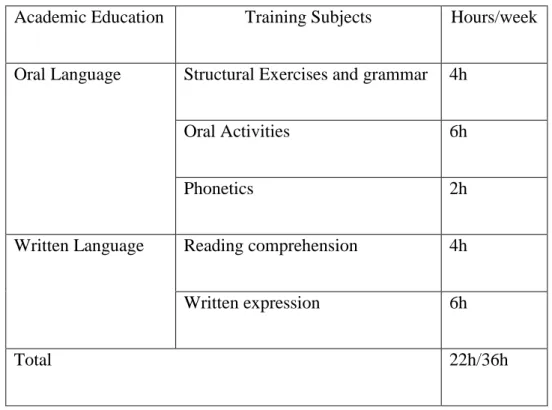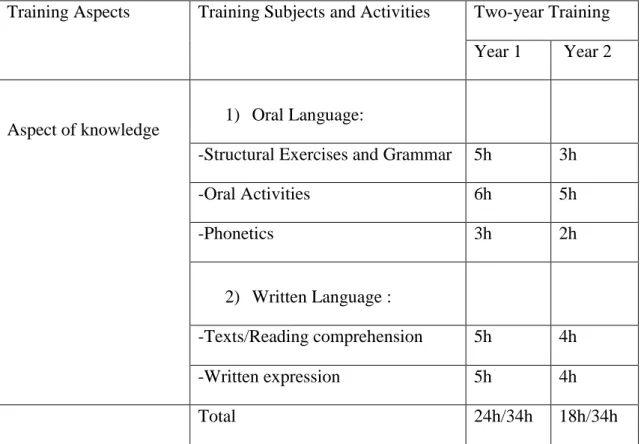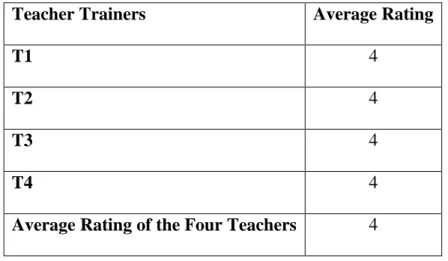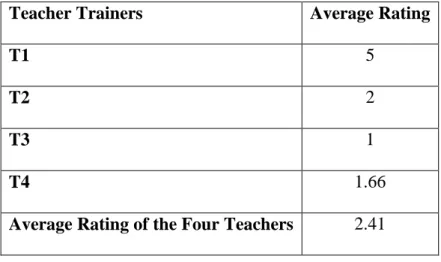People’s Democratic Republic of Algeria Ministry of Higher Education and Scientific Research
University “Frères Mentouri”, Constantine Faculty of Letters and Languages
Department of Letters and English Language
Implementing Competency Based Education in Initial Teacher Training in Algeria:
The Case of Pre-service Middle School Teachers of English
at the Higher Teacher Training School (Ecole Normale Supérieure) of Constantine
Thesis submitted to the Department of Letters and English Language in candidacy for the degree of Doctorat Es-Sciences in Applied Linguistics
By Mr. FADEL Mohamed Rafik Supervised by Prof. ABDERRAHIM Farida
Board of Examiners
Chairman: Prof. LARABA Samir University “Frères Mentouriˮ, Constantine Supervisor: Prof. ABDERRAHIM Farida University “Frères Mentouriˮ, Constantine Member: Prof. HOCINE Nacira University Badji Mokhtar, Annaba
Member: Prof. HAMADA Hacene Ecole Normale Supérieure, Constantine Member: Prof. BELOUAHEM Riad University “Frères Mentouriˮ, Constantine Member: Prof. HAMLAOUI Naima University Badji Mokhtar, Annaba
2016
ii Dedication
To my wife and children for their love, support and patience To my parents and siblings for their care and affections
iii
Acknowledgements
I would like firstly to acknowledge the support provided by my supervisor Professor Farida Abderrahim who directed me with patience and understanding. I express my gratitude for her encouragement and precious advice.
I am thankful to Dr Mohamed Reghioua, former director of the Ecole Normale Supérieure of Constantine, for his acceptance to carry my observation at the school, and to Mr Mehdi Gridi, former head of the English Department at the Ecole Normale Supérieure of Constantine, for his assistance in collecting data.
I also wish to address my sincere thanks to all the teachers and trainees who took part in the study for their time and cooperation without which the accomplishment of this research work would not have been possible.
Special thanks go to Dr Nasr-eddine Megherbi for hosting me at Universal Learning Center and providing me with all the necessary conditions to accomplish my research work with much comfort and ease.
I should like to acknowledge those ELT professionals, who inspired my work, Ms Ruth Goode, Ms Donna Brinton, and Ms Beth Neher. Watching these great trainers at work and discussing with them has stimulated and motivated me to carry my research in teacher education.
I here express my thanks to Prof. Samir Laraba, Prof. Nacira Hocine, Prof. Hacene Hamada, Prof. Riad Belouahem, and Prof. Hamlaoui Naima. Their acceptance to examine this work would give it more value.
I would like, now, to express my deepest gratitude and give special thanks to my partner in life, Rym Kemmouche. Without her intellectual support, serenity, love and inspirations in very hard moments, this work would not have been accomplished.
iv Abstract
Believing that the quality of education depends on the competence of teachers, the initial training of Middle School teachers in Algeria has been since 1999 the responsibility of a Higher Education institution to ensure providing teachers with high standards. In this context, our study aims at exploring the use of Competency Based Teacher Education at the Ecole Normale Supérieure of Constantine focusing on significant indicators namely attitude and performance. Using a mixed research paradigm, we observed four classes concerned with the teaching methodology course intended for fourth-year students of English, and then we investigated both the students’ and the teachers’ attitudes about the course through an attitudes questionnaire. We have also gathered trainees’ rating of their teaching competencies after the course through a self-rating questionnaire and compared it with the ratings of their supervisors and Middle School training teachers. Finally, we analyzed the lesson plans of the fifty trainees involved in the study after collecting their training copy books and rated their teaching performance using the same scale in the rating questionnaire. The results obtained from analyzing the classroom observation checklists indicate a tendency towards an applied science model approach in teacher education in the four subjects observed where the focus is on the knowledge to be acquired rather than on the competencies to be developed by the pre-service teachers. Likewise, the correlation test has shown a relative correlation between trainees’ self-rating of their teaching competencies and the ratings of their supervisors and training teachers. However, there was a weak association between these scores and the ones obtained from analyzing the lesson plans of the trainees who scored lower in performance than in their attitudes about their performance. The study describes findings about teacher education in Algeria and provides suggestions for the implementation of a competency-based model to prepare pre-service teachers for their future career.
Key words: Competency-Competency Based Education- Competency Based Teacher
v
List of Abbreviations
%: Percentage
∑: Total
AACTE: American Association of Colleges for Teacher Education AEF: Algerian English Framework
C: Competency
CBE: Competency Based Education
CBET: Competency Based Education and Training CBTE: Competency Based Teacher Education
CEF: Common European Framework of Reference for Languages C/PBTE: Competency/Performance Based Teacher Education
EFL: English as a Foreign Language ELT: English Language Teaching ENI: Ecole Normale d’Instituteurs ENS: Ecole Normale Supérieure
ENSC: Ecole Normale Supérieure of Constantine ESEA Elementary and Secondary Education Act ITE: Instituts Technologiques de l’Education L : Lesson
MDD: Material Design and Development MFE: Ministry of Fundamental Education MNE: Ministry of National Education MS: Middle School
vi
N: Number
ONS: Office Nationale des Statistiques p: p-Value
PBTE: Performance Based Teacher Education PEF: Professeur de l’Enseignement Fondamental PEM: Professeur de l’Enseignement Moyen r: Coefficient of Correlation
S: Student
SE: Secondary School Education Ss: Students
T: Teacher Trainer
TEFL: Teaching English as a Foreign Language TESD: Textbook Evaluation and Syllabus Design
UK NARIC: National Recognition Information Centre for the United Kingdom USOE: United States Office of Education
vii List of Tables
Table 3.1: The One-year Training Course Components Weekly Time Volume………….. 104
Table 3.2: Academic Education Subjects Time Allocation in the One-year Training Course for Teachers of English (1979- 1983)………. 105
Table 3.3: The Two-year Training Course Allocation of Time of the Academic Education Component in the Subject of English……… 106
Table 3.4: Weekly Time Volume of the Academic Education in the Three-year Training Course of the Subject of English………. 108
Table 4.1: Observation Checklist Statement 1………. 130
Table 4.2: Observation Checklist Statement 2………. 131
Table 4.3: Observation Checklist Statement 3………. 133
Table 4.4: Observation Checklist Statement 4………. 134
Table 4.5: Observation Checklist Statement 5………. 135
Table 4.6: Observation Checklist Statement 6………. 136
Table 4.7: Observation Checklist Statement 7………. 138
Table 4.8: Observation Checklist Statement 8………. 139
Table 4.9: Observation Checklist Statement 9………. 140
Table 4.10: Observation Checklist Statement 10………... 141
Table 4.11: Observation Checklist Statement 11………... 142
Table 4.12: Observation Checklist Statement 12………... 143
Table 4.13: Observation Checklist Statement 13………... 144
Table 4.14: Observation Checklist Statement 14………... 145
Table 4.15: Observation Checklist Statement 15………... 146
Table 4.16: Observation Checklist Statement 16………... 147
viii
Table 4.18: Observation Checklist Statement 18………... 150
Table 4.19: Observation Checklist Statement 19………... 150
Table 4.20: Observation Checklist Statement 20………... 151
Table 4.21: Observation Checklist Statement 21………... 153
Table 4.22: Observation Checklist Statement 22………... 154
Table 4.23: Observation Checklist Statement 23………... 155
Table 4.24: Observation Checklist Statement 24………... 156
Table 4.25: Observation Checklist Statement 25………... 157
Table 4.26: Observation Checklist Statement 26………... 158
Table 4.27: Observation Checklist Statement 27………... 159
Table 4.28: Observation Checklist Statement 28………... 160
Table 4.29: Observation Checklist Statement 29………... 161
Table 4.30: Observation Checklist Statement 30………... 162
Table 5.1: Teacher Trainers’ and Students’ Attitudes towards Statement 1……… 170
Table 5.2: Teacher Trainers’ and Students’ Attitudes towards Statement 2……… 171
Table 5.3: Teacher Trainers’ and Students’ Attitudes towards Statement 3 a………. 173
Table 5.4: Teacher Trainers’ and Students’ Attitudes towards Statement 3 b………. 174
Table 5.5: Teacher Trainers’ and Students’ Attitudes towards Statement 3 c………. 175
Table 5.6: Teacher Trainers’ and Students’ Attitudes towards Statement 3 d………. 176
Table 5.7: Teacher Trainers’ and Students’ Attitudes towards Statement 4……… 177
Table 5.8: Teacher Trainers’ and Students’ Attitudes towards Statement 5……… 178
Table 5.9: Teacher Trainers’ and Students’ Attitudes towards Statement 6……… 180
Table 5.10: Teacher Trainers’ and Students’ Attitudes towards Statement 7……… 181
Table 5.11: Teacher Trainers’ and Students’ Attitudes towards Statement 8 ………... 183
ix
Table 5.13: Teacher Trainers’ and Students’ Attitudes towards Statement 10 a…………... 185 Table 5.14: Teacher Trainers’ and Students’ Attitudes towards Statement 10 b…………... 186 Table 5.15: Teacher Trainers’ and Students’ Attitudes towards Statement 11…………... 187 Table 5.16: Teacher Trainers’ and Students’ Attitudes towards Statement 12…………... 188 Table 5.17: Teacher Trainers’ and Students’ Attitudes towards Statement 13 a…………... 189 Table 5.18: Teacher Trainers’ and Students’ Attitudes towards Statement 13 b…………... 190 Table 5.19: Teacher Trainers’ and Students’ Attitudes towards Statement 13 c…………... 192 Table 5.20: Teacher Trainers’ and Students’ Attitudes towards Statement 13 d…………... 193 Table 5.21: Teacher Trainers’ and Students’ Attitudes towards Statement 14…………... 194 Table 5.22: Teacher Trainers’ and Students’ Attitudes towards Statement 15 a…………... 196 Table 5.23: Teacher Trainers’ and Students’ Attitudes towards Statement 15 b…………... 197 Table 5.24: Teacher Trainers’ and Students’ Attitudes towards Statement 15 c…………... 198 Table 5.25: Teacher Trainers’ and Students’ Attitudes towards Statement 15 d…………... 199 Table 5.26: Teacher Trainers’ and Students’ Attitudes towards Statement 15 e…………... 200 Table 5.27: Teacher Trainers’ and Students’ Attitudes towards Statement 15 f………….... 201 Table 5.28: Teacher Trainers’ and Students’ Attitudes towards Statement 16 a…………... 203 Table 5.29: Teacher Trainers’ and Students’ Attitudes towards Statement 16 b…………... 204 Table 5.30: Teacher Trainers’ and Students’ Attitudes towards Statement 16 c…………... 205 Table 5.31: Teacher Trainers’ and Students’ Attitudes towards Statement 16 d…………... 206 Table 5.32: Teacher Trainers’ and Students’ Attitudes towards Statement 16 e…………... 207 Table 5.33: Teacher Trainers’ and Students’ Attitudes towards Statement 17 a…………... 208 Table 5.34: Teacher Trainers’ and Students’ Attitudes towards Statement 17 b…………... 209 Table 5.35: Teacher Trainers’ and Students’ Attitudes towards Statement 17 c…………... 210 Table 5.36: Teacher Trainers’ and Students’ Attitudes towards Statement 17 d…………... 211 Table 5.37: Teacher Trainers’ and Students’ Attitudes towards Statement 17 e…………... 212
x
Table 5.38: Teacher Trainers’ and Students’ Attitudes towards Statement 18 a ………….. 213 Table 5.39: Teacher Trainers’ and Students’ Attitudes towards Statement 18 b…………... 214 Table 5.40: Teacher Trainers’ and Students’ Attitudes towards Statement 18 c ………….. 215 Table 6.1: Trainees’, Training Teachers’ and Supervisors’ Rating of Competency 1……. 223 Table 6.2: Trainees’, Training Teachers’ and Supervisors’ Rating of Competency 2……. 224 Table 6.3: Trainees’, Training Teachers’ and Supervisors’ Rating of Competency 3……. 226 Table 6.4: Trainees’, Training Teachers’ and Supervisors’ Rating of Competency 4……. 228 Table 6.5: Trainees’, Training Teachers’ and Supervisors’ Rating of Competency 5……. 230 Table 6.6: Trainees’, Training Teachers’ and Supervisors’ Rating of Competency 6……. 232 Table 6.7: Trainees’, Training Teachers’ and Supervisors’ Rating of Competency 7……. 233 Table 6.8: Trainees’, Training Teachers’ and Supervisors’ Rating of Competency 8……. 235 Table 6.9: Trainees’, Training Teachers’ and Supervisors’ Rating of Competency 9……. 236 Table 6.10: Trainees’, Training Teachers’ and Supervisors’ Rating of Competency 10…... 238 Table 6.11: Trainees’, Training Teachers’ and Supervisors’ Rating of Competency 11…... 239 Table 6.12: Trainees’, Training Teachers’ and Supervisors’ Rating of Competency 12…... 241 Table 6.13: Trainees’, Training Teachers’ and Supervisors’ Rating of Competency 13…... 242 Table 6.14: Trainees’, Training Teachers’ and Supervisors’ Rating of Competency 14…... 243 Table 6.15: Trainees’, Training Teachers’ and Supervisors’ Rating of Competency 15…... 245 Table 6.16: Trainees’, Training Teachers’ and Supervisors’ Rating of Competency 16…... 247 Table 6.17: Trainees’, Training Teachers’ and Supervisors’ Rating of Competency 17…... 249 Table 6.18: Trainees’, Training Teachers’ and Supervisors’ Rating of Competency 18…... 250 Table 6.19: Trainees’, Training Teachers’ and Supervisors’ Rating of Competency 19…... 252 Table 6.20: Trainees’, Training Teachers’ and Supervisors’ Rating of Competency 20…... 253 Table 6.21: Trainees’, Training Teachers’ and Supervisors’ Rating of Competency 21…... 255 Table 6.22: Trainees’, Training Teachers’ and Supervisors’ Rating of Competency 22…... 257
xi
Table 6.23: Trainees’, Training Teachers’ and Supervisors’ Rating of Competency 23…... 258
Table 6.24: Trainees’, Training Teachers’ and Supervisors’ Rating of Competency 24…... 259
Table 6.25: Trainees’, Training Teachers’ and Supervisors’ Rating of Competency 25…... 261
Table 6.26: Trainees’, Training Teachers’ and Supervisors’ Rating of Competency 26…... 262
Table 6.27: Trainees’, Training Teachers’ and Supervisors’ Rating of Competency 27…... 264
Table 6.28: Trainees’, Training Teachers’ and Supervisors’ Rating of Competency 28…... 266
Table 6.29: Trainees’, Training Teachers’ and Supervisors’ Rating of Competency 29…... 267
Table 6.30: Trainees’, Training Teachers’ and Supervisors’ Rating of Competency 30…... 268
Table 6.31: Trainees’, Training Teachers’ and Supervisors’ Rating of Competency 31…... 270
Table 6.32: Trainees’, Training Teachers’ and Supervisors’ Rating of Competency 32…... 271
Table 6.33: Trainees’, Training Teachers’ and Supervisors’ Rating of Competency 33…... 272
Table 6.34: Trainees’, Training Teachers’ and Supervisors’ Rating of Competency 34…... 273
Table 6.35: Trainees’, Training Teachers’ and Supervisors’ Rating of Competency 35…... 274
Table 6.36: Trainees’, Training Teachers’ and Supervisors’ Rating of Competency 36…... 276
Table 6.37: Trainees’, Training Teachers’ and Supervisors’ Rating of Competency 37…... 277
Table 6.38: Trainees’, Training Teachers’ and Supervisors’ Rating of Competency 38…... 279
Table 6.39: Trainees’, Training Teachers’ and Supervisors’ Rating of Competency 39…... 280
Table 6.40: Trainees’, Training Teachers’ and Supervisors’ Rating of Competency 40…... 281
Table 7.1: Trainees’ Level of Performance of Competency 6………. 289
Table 7.2: Trainees’ Level of Performance of Competency 7………. 291
Table 7.3: Trainees’ Level of Performance of Competency 8………. 292
Table 7.4: Trainees’ Level of Performance of Competency 9………. 294
Table 7.5: Trainees’ Level of Performance of Competency 10………... 295
Table 7.6: Trainees’ Level of Performance of Competency 11………... 296
xii
Table 7.8: Trainees’ Level of Performance of Competency 13………... 299
Table 7.9: Trainees’ Level of Performance of Competency 14………... 300
Table 7.10: Trainees’ Level of Performance of Competency 15………... 301
Table 7.11: Trainees’ Level of Performance of Competency 16………... 302
Table 7.12: Trainees’ Level of Performance of Competency 17………... 303
Table 7.13: Trainees’ Level of Performance of Competency 18………... 304
Table 7.14: Trainees’ Level of Performance of Competency 19………... 305
Table 7.15: Trainees’ Level of Performance of Competency 20………... 306
Table 7.16: Trainees’ Level of Performance of Competency 21………... 307
Table 7.17: Trainees’ Level of Performance of Competency 22………... 308
Table 7.18: Trainees’ Level of Performance of Competency 23………... 309
Table 7.19: Trainees’ Level of Performance of Competency 24………... 310
Table 7.20: Trainees’ Level of Performance of Competency 25………... 311
Table 7.21: Trainees’ Level of Performance of Competency 26………... 312
Table 7.22: Trainees’ Self-rating and Teaching Performance………... 314
Table 7.23: Supervisors’ Rating and Trainees’ Teaching Performance………. 317
xiii List of Figures
Figure 1.1: Skill, Competence and Competency (Jordan, Carlile, & Stack , 2008, p. 203)… 44 Figure 1.2: Role Competence Model (Jordan, Carlile, & Stack, 2008, p. 204)……… 45 Figure 1.3: From Potential to Role Competence (Jordan, Carlile, & Stack, 2008, p. 206)….. 47 Figure 2.1: The Craft Model of Professional Education (Wallace, 1991, p. 6)……… 65 Figure 2.2: The Applied Science Model (Wallace, 1991, p. 9)……… 66 Figure 2.3: The Reflective Model (Wallace, 1991, p. 15)……… 68 Figure 7.1: Correlation between Trainees’ Self-rating and Teaching Performance…………. 316 Figure 7.2: Correlation between the Supervisors’ Rating and the Trainee’s Teaching
Performance...………
319 Figure 7.3: Correlation between Training Teachers’ Rating and Trainees’ Teaching
xiv
Table of Contents
General Introduction……….. 1
1. Statement of the Problem………... 1
2. Aims of the Study………... 2
3. Research Questions and Hypotheses………..….. 4
4. Methodology and Means of Research………..… 5
5. Definition of the Variables of the Study……….……. 7
6. Structure of the Thesis………. 9
Chapter One: Competency Based Education……….. 12
Introduction……….. 12
1.1.Theoretical Background of Competency Based Education……… 12
1.1.1. The Behaviourist Stream……… 13
1.1.1.1. Behaviorism in Education………... 13
1.1.1.2. Shortcomings of Behaviorism………... 14
1.1.1.3. Behaviorism and Competency Based Education……… 15
1.1.2. The Cognitive Movement………... 17
1.1.3. The Constructivist Movement……….. 20
1.1.3.1.Main Theorists of Consctructivism: Piaget, Vygotsky and Bruner………. 20
1.1.3.2.Constructivism in Education………... 25
1.1.3.3.Criticism of Constructivism………. 27
1.1.3.4.Constructivism and Competency Based Education………. 29
1.2. Definition of Competency Based Education………... 30
1.2.1. Characteristics of Competency Based Education………... 31
xv
1.2.2.1. Competency………... 34
1.2.2.2. Competence………... 41
1.2.3. Operational Definition of Competence and Competency……….. 46
1.3. Educational Implications of Competency Based Education………. 49
Conclusion………. 52
Chapter Two: Initial Teacher Education in Language Teacher Education………... 54
Introduction……… 54
2.1. Teacher Training versus Teacher Education………... 55
2.1.1. Teacher Training………... 55
2.1.2. Teacher Education………... 57
2.2. The Micro and Macro Approaches to Teacher Education………... 59
2.3. Models in Teacher Preparation………... 61
2.3.1. Structural Models………. 61
2.3.2 Conceptual Models……… 63
2.3.3. Organizational Models……….. 69
2.4. Practice in Teacher Education………... 70
2.4.1. Models of Practice in Teacher Education………... 71
2.4.2. Models and Types of Supervision………. 72
2.5. Professional Preparation in Language Teacher Education……….. 74
2.6. Competency Based Teacher Education……… 78
2.6.1. Political and Social Context of Competency Based Teacher Education………... 78
2.6.2. Criticism of Competency Based Teacher Education………... 87
2.6.3. Competency Based Teacher Education in the Reform of Teacher Education………. 89
xvi
Chapter Three: The Training of Middle School Teachers in Algeria: 1962-2015…………. 91
Introduction……… 91
3.1.The No-institution Training Period (1962-1970)………. 91
3.2.Training at the Institute of Technology of Education (1970-1998)………. 93
3.2.1. Evolution of Middle School Teacher Training at the Institutes of Education………. 94
3.2.2. Organization of the Training at the Institutes of Education………. 97
3.2.2.1. Students’ and Trainers’ Profiles at the Institutes of Education………. 97
3.2.2.2. Duration of the Training Course at the Institutes of Education……….... 101
3.2.3. Content of the Training Course at the Institutes of Education………. 102
3.2.3.1. The Theoretical Content of the Course at the Institute of Education……… 103
3.2.3.2. The Practical Content of the Course at the Institute of Education……… 109
3.2.4. Course Assessment at the Institutes of Education……… 112
3.3.Training at the Ecole Normale Supérieure 1999-2015……… 113
3.3.1. Educational Organization at the Ecole Normale Supérieure……… 114
3.3.1.1. Admission to the Ecole Normale Supérieure……… 114
3.3.1.2. Trainers’ Profile……… 115
3.3.2. Content of the Training Course at the Ecole Nornale Supérieure……… 116
3.3.2.1.Theoretical Component of the Course at the Ecole Normale Supérieure………... 117
3.3.2.2.Practical Component of the Training Course at the Ecole Normale Supérieure………… 119
Conclusion……….. 122
Chapter Four: Classroom Observation at the Ecole Normale Supérieure of Constantine 124 Introduction………. 124
4.1. Design and Methodology of Classroom Observation………... 125
xvii
4.1.2. The While-observing Phase……….. 127
4.1.3. The Post-observation Phase……….. 127
4.2. Analysis of the Classroom Observation of the Teaching Methodology Subjects…... 129
4.2.1. Objectives………. 130
4.2.2. Content and Methodology……… 134
4.2.3. Assessment………... 148
4.2.2. Training Competencies………. 152
4.3. Discussion of the Results of the Classroom Observation……… 163
Conclusion……….. 165
Chapter Five: The Trainees’ and Trainers’ Attitudes about the Course at the Ecole Normale Supérieure of Constantine……… 166
Introduction………. 166
5.1. Description of the Teacher Trainers’ and Students’ Attitudes Questionnaire………. 166
5.2. Analysis of the Teacher Trainers’ and Students’ Attitudes Questionnaire……….. 169
5.2.1. Objectives of the Course………... 169
5.2.2. Content of the Course………... 172
5.2.3. Methodology Used in the Course………. 180
5.2.4. Teaching Techniques and Assessment Used in the Course……….. 195
5.3. Overall Analysis……….. 216
Conclusion……….. 217
Chapter Six: The Rating of the Trainees’ Competencies………... 219
Introduction………. 219
6.1. Description and Administration of the Trainees’ Teaching Competencies Questionnaire……….. 219
xviii
6.1.1. Description of the Trainees’ Teaching Competencies Questionnaire……….. 220
6.1.2. Administration of the Trainees’ Teaching Competencies Questionnaire………. 221
6.2. Analysis of the Results of the Trainees’ Teaching Competencies Questionnaire…... 222
6.2.1. Teaching Methodology Competencies………. 222
6.2.2. Lesson Planning Competencies……… 231
6.2.3. Lesson Presentation Competencies………... 247
6.2.4. Classroom Management Competencies……… 264
6.2.5. Assessment Competencies……… 276
6.3. Overall Results………. 283
Conclusion……… 284
Chapter Seven: The Trainees’ Performance in the Lesson Planning and Lesson Presentation Competencies……….. 285
Introduction……… 285
7.1. Description of the Procedure of the Full-time Training Phase Lessons’ Analysis…………. 285
7.1.1. Collecting the Lessons……….. 286
7.1.2. Analysis of the Lessons……… 287
7.2. The Trainees’ Level of Performance in the Full-time Training Phase Lesson Planning and Lesson Presentation Competencies………... 289
7.2.1. Lesson Planning Competencies……… 289
7.2.2. Lesson Presentation Competencies………... 302
7.3. The Correlation between the Trainee’s Teaching Performance and Attitudes about their Performance Level……….. 313
7.3.1. Trainees’ Self-rating and Teaching Performance………. 313
7.3.2. Supervisors’ Rating and Trainees’ Teaching Performance……….. 316
xix
7.4. Overall Analysis……….. 322
Conclusion……….. 323
Chapter Eight: Pedagogical Implications: Implementing Competency Based Education in the Methodology Courses at the Ecole Normale Supérieure of Constantine... 325
Introduction………. 325
8.1. Textbook Evaluation and Syllabus Design Lesson Plan in a Competency Based Education Context………. 326
8.2. Teaching of English as a Foreign Language Lesson Plan in a Competency Based Education Context……….. 331
8.3. Materials Design and Development Lesson Plan in Competency Based Education Context……… 340 8.4. General Comments……….. 347 Conclusion……….. 348 General Conclusion……… 350 References………... 355 Appendices
Appendix A: The Observation Form Appendix B: The Observed Lessons Appendix C: The Observation Checklist Appendix D: The Attitudes Questionnaire
Appendix E: Trainees’ Teaching Competencies Questionnaire Appendix F: The Teacher Competency Framework
Appendix G: Sample Trainee’s Lesson Plans Appendix H: Model Training Lesson Plans
General Introduction
3. Statement of the Problem 4. Aims of the Study
3. Research Questions and Hypotheses 4. Methodology and Means of Research 5. Definition of the Variables of the Study 7. Structure of the Thesis
1
General Introduction 1. Statement of the Problem
The changing and developing notion of education has raised the question of teacher training because teachers constitute one of the variables that determine the quality of teaching since the students’ performance mostly depends on the teaching practices (Darling-Hammond & Bransford, 2005). Therefore, enhancing the quality of education relies first on the identification of the required teachers’ competencies and, then, on making pre-service teachers acquire them (Feiman-Nemser, 2001, 2008). In other words, increased educational quality requires identifying both the standards of the teacher training institutions and the minimum qualifications that pre-service teachers should develop. The specific skills of today’s teachers are encapsulated in their competencies about content knowledge, professional knowledge, and pedagogical content knowledge around the world. (Shulman, 1986)
Teacher competencies serve various purposes such as contributing to support the national education objectives, creating a framework to compare teachers’ qualifications and quality, in addition to creating consistency in social expectations toward the position and quality of the teaching profession. For this reason, it is necessary that theoretical and applied studies should be raised above a certain level to help pre-service teachers acquire the qualifications in question throughout their education process. The present study is useful in directing initial teacher training in Algeria with particular reference to pre-service Middle School teachers of English.
In search of a more qualified and competent teacher, the education of Middle School teachers has been taken in charge, since 1999, by a higher education institution namely the Higher Teacher Training School (Ecole Normale Supérieure). This procedure shows according to
2
the authorities’ awareness that teacher training is a master piece in any school system. The success or failure of an education system depends on the vision we have of the teacher, the quality of training and skills to achieve as declared by the director of the Higher Teacher Training School of Constantine (Ecole Normale Supérieure of Constantine) to El Watan Newspaper (Boussaid, 2009). However, the academic training takes primacy over the professional in the preparation of teachers where the organization of the development of teachers has not changed since the time of the Institutes of Technology of Education launched in the 1970s; the model followed is still the apprenticeship model with an applied science touch. This situation has led to providing teachers who are unable to understand the curriculum adopted by the Ministry of National Education and implement it to get the required pupil exit profile in light of the reforms initiated in 2004 emphasizing the construction of meaning through reflection.
2. Aims of the Study
This study explores the different aspects involved in initial training at the Ecole Normale Supérieure of Constantine. Our focal intent is to examine to what extent pre-service Middle School teachers of English are prepared for their future profession of Teacher of English as a Foreign Language in Algeria. Another aim is to propose model lessons to train Algerian future teachers to develop awareness of Competency Based Language Teaching and develop skills in implementing it in the Algerian school.
The study targets Fourth Year students of English at the Ecole Normale Supérieure of Constantine, students who are in their final year of study before they obtain the degree of Middle School teacher (Professeur de l’Enseignement Moyen). To make generalization possible and because the students’ number is not very large (fifty-four students), the study addresses the entire population. However, because four students were absent when the study was conducted, the
3
sample includes only the fifty students who answered the questionnaires and submitted their training copybooks for analysis. This sample could be said to be very representative since it covers 92.59%.
As for the teachers, they include three categories: Methodology subjects’ teachers, supervisors and training teachers. The teachers of the following Methodology Subjects: Teaching English as a Foreign Language, Textbook Evaluation and Syllabus Design, and Material Design and Development at the Ecole Normale Supérieure of Constantine were all involved in classroom observations and in answering the attitudes about the course questionnaire. Twelve teachers, who represent all the pre-service teachers’ supervisors from the Ecole Normale Supérieure of Constantine, responded to the competencies rating questionnaire. Fourteen training teachers (professeurs d’application de l’enseignement moyen) who have been involved in the practical training at the placement schools have also rated their trainees’ competencies by answering the competencies rating questionnaire.
We, hence, explore the students and teachers’ attitudes about the training course at the Ecole Normale Supérieure of Constantine. We, also, aim to determine the positions of the different stakeholders concerned with teacher education (students, training teachers and supervisors) about the acquired teaching competencies as a result of training. The third aim is to investigate the teaching practices at the Ecole Normale Supérieure of Constantine regarding the training model provided by the trainers and its relationship with what the trainees are expected to do in their future career as teachers at the level of the Middle School. We examine how the students shift during their training from ‘savoir’ to ‘competencies’. We explore how the teachers’ role is of great importance in promoting the trainees’ standards, in particular with the application of the Competency Based Approach in the Algerian schools. We, then, consider to what extent
4
the students can transfer the knowledge and skills they focus on during their education at the Ecole Normale Supérieure of Constantine into actual teaching competencies when planning and presenting lessons during the practical training period. We, finally, demonstrate whether the implementation of the Competency Based Education in teacher training is necessary to obtain the required teacher profile. The results achieved from this research work will help design model lessons for teacher education to pre-service Middle School teachers of English as a Foreign Language to boost the development of Competency Based Education at the Ecole Normale Supérieure.
3. Research Questions and Hypothesis
In agreement with the previous research aims, the study attempts to answer the following questions:
1. Which model of teacher education is used at the Ecole Normale Supérieure of Constantine to prepare pre-service Middle School teachers of English for their future career?
2. To what extent is the teaching in the training course effective in developing the required teaching competencies?
3. What are the trainees’ attitudes about the training course at the Ecole Normale Supérieure of Constantine?
4. What are the trainers’ attitudes about the training course at the Ecole Normale Supérieure of Constantine?
5. Do the trainers’ attitudes about the course correlate with the extent to which the course focuses on developing teaching competencies?
5
6. Do the trainees’ attitudes about their competency level correlate with the competency level which they have actually acquired as reflected in their training copybooks?
7. Do the trainers’ attitudes about the trainees’ competency levels match those of the trainees and their actual teaching competencies?
To answer these research questions, we formulate the following hypotheses:
1. If the trainers were aware of the characteristics of Competency Based Education, they would apply them in their classes.
2. If the trainees’ were aware of the required competencies, their self-rating to their teaching competencies would correlate with their teaching performance in the practical training. 3. If the trainers were aware of the required competencies, their rating of the trainees’
competencies would correlate with the trainees’ self-rating and with their actual teaching performance.
4. If the trainers adopted Competency Based Education in the training at the Ecole Normale Supérieure of Constantine, the trainees would develop the necessary teaching competencies as described in the Algerian English Framework.
4. Methodology and Means of Research
This study adopts the mixed research paradigm, defined by Johnson and Onwuegbuzie (2004) as “the class of research where the researcher mixes or combines quantitative and qualitative research techniques, methods, approaches, concepts or language into a single study” (p. 17). A mixed approach to research, recognized nowadays as the third research paradigm, helps researchers benefit from the strengths of its past research traditions. This model gives them more flexibility to adjust their research methods and techniques into their research questions
6
rather than being forced to fit their designs into either qualitative or quantitative methods (Johnson & Onwuegbuzie, 2004). The combination of methods from both approaches allows us to have a better understanding of English as a foreign language teacher education in Algeria.
Within this mixed research framework, Nunan (1992) outlined Grojahn’s pure and mixed forms model (1987). This model classifies applied linguistic research according to the method of data collection (experimental or nonexperimental), the nature of the collected data (qualitative or quantitative) and the method of data analysis (statistical or interpretive). Concerning this model, our study is on the one hand exploratory-quantitative-statistical due to the use of questionnaires and correlation tests. On the other hand, we adopt the exploratory-quantitative-interpretive paradigm in the analysis of the classroom observation sessions and the students’ training copybooks.
The qualitative part of our study is descriptive providing a detailed account on how we train Pre-service Middle School teachers at the Ecole Normale Supérieure of Constantine. In its quantitative part, the study is correlational. On the one hand, it seeks to determine the relationship between the approach adopted in training student teachers and the extent to which they achieve in the different teaching competencies. On the other hand, it helps finding out whether a correlation exists between the trainers’ and the trainees’ attitudes about teaching competencies and the extent to which the trainers focus on these competencies in training the students in addition to how much the trainees acquire such competencies.
This non-experimental research work relies on three means of research: classroom observation, questionnaires (attitudes about the course and competencies rating), and content analysis (analysis of the students’ training copybooks). Observation concerns the subjects, at the
7
Ecole Normale Supérieure, that directly relate to teacher education and the trainees’ professional development: Teaching English as a Foreign Language, Textbook Evaluation and Syllabus Design, and Materials Design and Development. We use records of classroom teaching practices in order to examine the model of teacher education adopted by the Ecole Normale Supérieure instructors. Moreover, we use an observation grid to check the teaching competencies, if any, addressed by the three methodology subjects. Two questionnaires are used to investigate different areas of our research work: the attitudes about the course questionnaire and the competencies rating questionnaire. The first one is the attitudes questionnaire delivered to the trainees at the end of their final year at the Ecole Normale Supérieure of Constantine to measure their attitudes about the training course. This questionnaire handed to the teachers of the three methodology subjects which are related to the professional aspect of their training is to help compare the attitudes of the teacher trainers with those of the pre-service teachers. The second one is the competencies rating questionnaire handed to the pre-service teachers to rate their teaching competencies acquired after training. The same questionnaire is used to verify consistency with the rates given by the trainees by submitting it to their supervisors from the Ecole Normale Supérieure and their Middle School training teachers. Because of the impossibility of observing pre-service teachers’ class performance during the practical training phase, we analyze the training copybooks to measure their performance at the different teaching competencies based on the teaching competencies grid used in the self-rating questionnaire.
5. Definition of the Variables of the Study
Our research work contains three variables, namely competencies, Competency Based Education, and attitudes.
8
The term competency is a complex construct that is impossible to explain through a single simple definition. The behaviorist view considers competency as the behavior(s) and, where appropriate, the attribute that individuals must possess, or must acquire, to perform effectively at work (Short, 1984). Short stated that competency has come to refer to a specified attribute that may be possessed by someone, perhaps within a series of related competencies. These competencies suggest both a particular category on which we may judge a person’s adequacy or sufficiency and quality or state of being competent, able, adequate or sufficient within such a category. Similarly, Irwin (2008) considered that the behavior is the attribute that individuals must have, or must acquire, to perform effectively at work. On the other hand, a constructivist view of this concept regards it as competency. Competency consists of a description of the combination of the knowledge, skills and attitudes required for effective performance of a real-world task or activity or for carrying out professional tasks (Mrowicki, 1986; Marelli, Tondora, & Hoge, 2005). In the light of these different views, an operational definition of this variable is essential to avoid confusion as to what we mean by competency in this research work. In this study, the term competency is to be understood as any of the forty teaching competencies stated in the Teacher Competency Framework developed by World Learning / School of International Training experts together with members of the “Groupe Spécialiste en Didactique” (GSD-anglais) and a pilot group of English inspectors in Algeria.
Competency Based Education is a movement in teaching that promotes stating objectives taking into consideration “precise, measurable descriptions of the knowledge, skills, and behaviors students should possess at the end of a course of study” (Richards & Rodgers, 2001, p. 141). Accordingly, Competency Based Teacher Education is a movement that emerged in 1968 as a response to the dissatisfactions in education in the United States. The Office of Education,
9
then, offered grants to develop model training programs for the preparation of elementary school teachers in which the focus in teacher education should be on teachers’ ability to perform specific, measurable tasks (Eraut, 1994). The model designed for this study considers the components of Competency Based Education as sketched out by Weddel (2006) and which include an assessment of the learners’ needs that is organized to define what is required to improve their performance. The model involves the selection of the competencies to be developed into statements of learning objectives and outcomes, then, the target instruction and the instructional material to be used, and an evaluation of the competency attainment to determine the level of its achievement.
An attitude is an opinion and evaluation a person may give on a particular topic, object or event. According to McLeod (2009), the most straightforward way of finding out about someone’s attitudes would be to ask the person. Attitudes have been the focus of research in different fields which used survey questionnaires to measure them. In these questionnaires, the attitude object is introduced as the stimulus which the respondents have to respond to according to an attitude scale designed to provide a valid, or accurate, measure of the opinions gathered. Therefore, attitudes in this study are defined regarding the ratings the participants give about the training course at the Ecole Normale Supérieure of Constantine. They have been measured using a five-point Likert scale in which the subjects expressed their agreement/ disagreement with different statements about the training course.
6. Structure of the Thesis
The thesis comprises two major parts. The first part is a literature review in which we discuss the most important issues related to the topic under investigation and clarify the concepts
10
we deal with in our study; it includes three chapters. The second part is concerned with the field of investigation and consists of five chapters: the first four chapters thoroughly describe the steps of the research work and the results obtained from the inquiry, and the last chapter provides useful recommendations on the implementation of Competency Based Teacher Education.
In Chapter One, Competency Based Education, we explore the theoretical origins of the Competency Based Education movement, clarify the concepts of its key components and state the educational implications that result from its application. Chapter Two, Initial Teacher Education in Language Teacher Education, is concerned with teacher education. It presents the history of teacher education and how this field has evolved. It also discusses the most significant transitions that have marked teacher education, and the challenges met as a result of these developments. Chapter Three, The Initial Training of Middle School Teachers in Algeria, gives a descriptive review of the initial training program for Middle School teachers in Algeria since its independence in 1962. It provides an overview of the historical development of teacher training being the responsibility of two different institutions namely the Institutes of Technology of Education and The Ecole Normale Supérieure. Chapter Four, Classroom Observation of the Teaching Methodology Subjects at the Ecole Normale Supérieure, is the first of the practical chapters of this study. It gives a detailed account of the classroom observation we have conducted at the Ecole Normale Supérieure of Constantine. It provides a detailed description of the research procedures we underwent when observing classes and offers both qualitative and quantitative analysis of the results concerning the training methodology adopted at the Ecole Normale Supérieure of Constantine. Chapter Five, Teacher Trainers and Students’ Attitudes towards the Training Course at the Ecole Normale Supérieure, is concerned with students’ and teachers’ attitudes about the course. The results obtained are compared among the different
11
participants and are also used to check their relevance to the training model observed in the previous chapter. Chapter Six, Exploring the Rating of the Trainees’ Competencies, is about the rating of teaching competencies of pre-service teachers of English at the Ecole Normale Supérieure of Constantine. It affords an explanation of the methodology used to collect the data and combines qualitative and quantitative analysis of the findings. In Chapter Seven, Trainees’ teaching Performance in the Lesson Planning and the Lesson Presentation Competencies, we try to analyze teaching competencies through an analysis of pre-service teachers’ lessons as recorded in their training copybooks. We compare the results obtained to the ratings provided by students, training teachers and supervisors through the competency rating questionnaire. The last chapter, Chapter Eight, Pedagogical Implications: Implementing Competency Based Education in the Methodology Subjects at the Ecole Normale Supérieure includes suggestions of a model of initial teacher training in Algeria. Based on previous literature and the results obtained from the study, it presents a framework for Competency Based Teacher Education by providing model lesson plans for teacher educators that would enable them to help their trainees develop the key competencies they need for their profession.
Chapter One
Competency Based Education Introduction
1.2.Theoretical Background of Competency Based Education 1.1.1. The Behaviourist Stream
1.2.1.1. Behaviorism in Education 1.2.1.2. Shortcomings of Behaviorism
1.2.1.3. Behaviorism and Competency Based Education 1.2.2. The Cognitive Movement
1.2.3. The Constructivist Movement
1.2.3.1.Main Theorists of Consctructivism: Piaget, Vygotsky and Bruner 1.2.3.2.Constructivism in Education
1.2.3.3.Criticism of Constructivism
1.2.3.4.Constructivism and Competency Based Education 1.2. Definition of Competency Based Education
1.2.1. Characteristics of Competency Based Education 1.2.2. Competency versus Competence
1.2.2.1. Competency 1.2.2.2. Competence
1.2.3. Operational Definition of Competence and Competency 1.3. Educational Implications of Competency Based Education Conclusion
12 Chapter One
Competency Based Education Introduction
Education systems around the world have known important reforms that can be qualified as revolutions in pedagogy given the significant changes brought by new paradigms. One of these models in teaching which generates significant tension is the competency-based pedagogy which when applied affects the entire education system from the preparation of teachers to the different classroom practices and tasks. We introduce this educational model by exploring its theoretical background to define the key elements that make it.
1.3.Theoretical Background of Competency Based Education
The empirical vision of thinking which claims that learning necessitates only being in a situation of reception was the idea prevailing in the field of education until the middle of the twentieth century. New theories namely: Behaviourism, Cognitivism, and Constructivism started, then, to gain ground and have been the main paradigms that have marked the world of education.
In a search to clarify the different aspects of Competency Based Education (CBE), it is essential to explore this movement’s background and trace the theoretical context in which it has emerged and evolved. The concept competency can be traced back and categorized as having its genesis in the behaviorist trend and then evolving to include cognitive and constructivist characteristics. Understanding these trends among learning theories and their limitations is fundamental to have a clear idea about the origins and development of CBE as Harris, Guthrie, Hobart and Lundberg (1995) suggested.
13 1.1.1. The Behaviourist Stream
When pointing to the origins of the competency movement in education, Quinn (1993) stated that CBE had its roots in the movement of behaviorist psychology that would attract few contemporary adherents (p. 56). Doll (1984) reported that the movement was one part of a broader behaviorist perspective. Hall and Jones (1976) believed firmly in it and its efficacy and stated that the prime characteristic of CBE is “an emphasis on specification of learner outcomes regarding behavioral objectives” (p. 6). Behaviorism is, then, seen as its precursor.
Behavioral psychology or behaviorism drew its inspiration from the tradition of ‘British Empiricism’; the philosophy which worked on the premise that our sensory experience is the ultimate foundation of our knowledge and that it furnishes us with knowledge over time. This British approach to the philosophy of mind was given an American twist by thinkers such as William James (1842-1910) and John Dewey (1859-1952), who believed in their works that the real question was not so much how our knowledge is derived from experience, but how our action is shaped by experience (Gagné, 1965).
1.3.1.1. Behaviorism in Education
Behaviorism is the first leading theory of learning which has marked the fields of education, teaching, and training. John B Watson (1878-1958), an American psychologist, is its promoter founding his learning theory on the association of a world event and a stimulus-response while denying the role of the mind or consciousness. According to the behaviorist theory, learning is defined as the enduring modification of behavior, behavior being the set of the objectively observable reactions of a body that reacts to a stimulus (Pavlov, Thorndike, Skinner). The behaviorists are interested in this observable behavior and consider that there is
14
learning when the learner gives a correct response to a given stimulus. This conclusion leads us to illustrate the idea of behaviorism by the relation Stimulus-Response showing a direct response of the body to a stimulus coming from the environment and leading to learning by association (Basque, Rocheleau, & Winer, 1998). As a learning theory, it is considered as a process of forming habits where the repetitive conditioning of the learner’s responses is emphasized. The teacher is responsible for the learning environment, and learners are empty vessels into which the teacher pours knowledge. Therefore, this process is viewed as automatic, not involving any mental activity which takes part in the brain when learning.
1.3.1.2. Shortcomings of Behaviorism
Nowadays, the critics of behaviorism in general and teaching by objectives, in particular, are numerous even if this theory is at the origin of many signs of progress in education and despite their effects on training programs, on the competencies developed by the learners and on their attitudes facing learning. First, although the behaviorist model obliges the teacher to focus on the student and on the intellectual activity which the latter must achieve, splitting up knowledge and associating an objective with every task leads to loading down the teacher with multiple pedagogical goals difficult to manage. In addition to the effect it has on the teacher, this parsing does not permit the learner to have a global vision of his training in order to help the integration of knowledge because, in terms of learning, the whole can be different from the sum of the parts that compose it. Second, in trying to minimize the difficulties associated with some learning, we may lead the learners to some tasks that make them learn little. Behaviorists argued that teachers could link together content involving lower level skills and create a learning ‘chain’ to teach higher skills. However, high levels skills such as solving problems, argumentation, and critical analysis are neglected, and concentration is mainly on lower levels intellectual skills such as memorization, defining and illustrating concepts, application, and execution (Legendre, 2005; Tardif, 2006). Third,
15
teaching concentrating on behavioral objectives is centered on content and on storing knowledge. However, as Lebrun (2007) stated, this knowledge is not contextualized and for that reason it is reused with difficulty by the learner in other situations. A fact revealed by many pieces of research realized in a school context where little reinvestment and transfer of knowledge was noticed (Legendre, 2001).
By the 1960s, behaviorists proposed the integration of the mental conceptions and learning processes; an idea that led to the apparition of cognitivist theories. According to Scallon (2004), the object of reform implemented around the world is not only the adaptation of the educational system to the modern world’s requirements; it is also a calling into question of the educational system effectiveness. He regretted the lack of capacity in the learners who have finished their studies to use their knowledge and their skills to solve problems or accomplish daily life tasks. Since some years, training institutions are calling into question the teaching by objectives approach and programs devoted to subject based contents (Hodge, 2007).
1.3.1.3. Behaviorism and Competency Based Education
The theory of behaviorism with its emphasis on learning theory has strongly influenced the development and general approach of CBE. When we deal shortly with specific contributions to CBE, it will become apparent that many of its elements bear the behavioral imprint. The emphasis on the expression of competencies in behavioral terms which relate to the Experimentalists’ belief that learning is considered as a change in behavior (Ross, 1982; Klingstedt, 1973), and the focus in assessment on the observable behavior of the learner are the most prominent legacies of behavioral psychology.
Hodge (2007), Bowden (1995), and Bowden and Masters (1993), Nunan (1988) all associated the descent of the CBE movement mostly with the behavioral objectives
16
movement of the 1950s. Tyler (1949) argued that training would be more useful if we name the expected result and if we say what we exactly expect from the learner to do at the end of the training in precise terms showing an observable behavior. Malan (2000, p. 23) wrote that “incongruity between what is being taught and what is being learned led to the setting of objectives for teachers and learners.” He declared that, in 1949, Tyler gave further impetus to the objectives-oriented movement by stressing the importance of goals in curriculum design and teaching practices. This type of teaching methodology has supplanted traditional teaching. In 1962, Mager’s studies went on the continuum of the development of this movement. His work helped develop the imagination of many teachers and contributed to the start of a movement of interest in objectives. When proposing a very precise formulation of the pedagogical aim, he considered that it must contain an action verb that describes the required performance on the side of the student, a description of the conditions of realization and the performance criteria. The objectives movement, which invaded the American educational system at the end of the 1960s, widely used Bloom and Mager’s pedagogical objectives in the conception of training programs, training activities and lessons (Bloom, 1956; Mager, 1962). Melton (1994) claimed that the notion of competency has much in common with behavioral objectives. The same assertion is made by Pearson (1984) who believed that CBE endorses the same theory as the behaviorist school where the acquisition of knowledge is developed by rewarding a correct response and changing the person’s behavior. He explained that “competency is used in discussions of education that arise out of the behaviorist ideology under which a person is what his environment shapes him to be” (p. 36). This view can be associated with Locke’s idea of tabula rasa where the only experience determines what a person will be, an idea much supported by the experimentalist movement lead by Dewey. In this sense, we only need appropriate training to develop competency regardless of what the trained person brings to the situation and judge if they
17
became competent by the simple observation of his/her performance. Pearson suggested, then, the dependent relation between behaviorism and CBE even if “there is nothing in the concept of competency that logically assumes the behaviorist ideology” (p. 36). CBE programs were influenced by research findings in behavioral psychology. Houston (1985) stated that:
[CBE] assumes that humans are goal oriented and that they are more likely to achieve such goals and objectives when overt actions are taken to achieve them. Advocates point out the research basis for this position ... in the studies of behaviorally stated objectives. (p. 901)
Pearson (1984) believed, also, that advocates of CBE programs for teachers belong to the behaviorist school of thought focusing on the development of behavioral objectives and opponents of these programs are critics of behaviorism known as humanists.
1.3.2. The Cognitive Movement
Many researchers in different domains questioned behaviorist theories that ignored the human conscience and whose influence has been dominant since the beginning of the century. As a reaction to behaviorism, the 1950s cognitive revolution combined new theories in psychology and linguistics with the new technologies and new sciences as computing and neuroscience.
The discoveries realized in the field of cognitive sciences provide us with valuable information on the way the human mind treats information coming from the environment. According to the cognitive school of thought, the continuous refinement of understanding formed by past experiences and new ones helps acquire knowledge. The cognitive learning theory emphasized, in this sense, the learner’s cognitive activity and mental operations as
18
reasoning, memorization, problem solving, and knowledge transfer rather than habit formation.
Tenants of the cognitivist theory seek, contrary to the behaviorists, to highlight the internal processes of learning. Ausubel (1963) and Gagné (1965) were among the most influential authors who developed this theory. According to them, the learner is an active system of information treatment, similar to a computer. Ausubel and Gagné have first looked into the physical components of the human memory and into the way information is stored, represented and illustrated by the human brain. They concluded that the human brain stores information in his memory treats it, and solves problems. This process of data treatment was schematized in 1976 by Gagné. He explained how the information (stimulus) that comes from the environment in different forms (visual, auditory, olfactory, tactile, etc…) was treated and interpreted. The information is captured by the senses to be transmitted to the sensorial memory where it is decoded. As soon as the short term memory receives the information, it must be interpreted and analyzed by the individual. However, to achieve that, he has to reactivate the knowledge stored in his long term memory. From this activity of interpretation emerges a symbolic construction in the form of schemes or representations which can be concepts, propositions or procedures considered as generative memorial structures that help the human being to picture the reality and work on it. The notion of schemes has been introduced by the British researcher Frederick Charles Bartlett (1886-1969) who has demonstrated that subjects who read exotic stories use their general anterior knowledge to reconstruct the information. In fact, when these subjects recount the same stories, they bring some distortions which are the reflection of their references.
Cognitivists agree with the behaviorists that there is an external objective reality, but they add that the learner must integrate this fact to his proper mental schemes. Therefore, what characterizes cognitivist learning is a change in the student’s mental structure. The
19
teacher uses teaching strategies which would help the learner select and encode the information coming from the environment. She/he introduces organizing schemes at the moment the student confronts a new content. This process contributes to making links with the anterior knowledge, organizes and integrates this information by showing cognitive charts, encouraging taking notes, helping to form significant mental images, and by asking to produce summaries, etc. Hence, for the cognitivist, learning is considered as a change in the mental structures or the internal representations of the individuals. It is an active process of information treatment and problem-solving. The vision of education that follows this paradigm considers the active engagement of the learners during the learning process to treat the information deeply. It goes beyond the behaviorist learning of facts and skills, adding cognitive apprenticeship to the learning process in which learners are encouraged to work out rules deductively for themselves. It focuses on building their experiences and providing tasks that can challenge, but also function as intellectual scaffolding to help develop learning and progression through the curriculum. The Cognitive theory, according to Atherton (2005), focuses mostly on the way we understand the material; it is interested in the aptitude and capacity to learn in addition to the learning styles.
The attempt to establish a link between a school centered on the observable behavior and a school based on the individual’s cognitive development has considerably grown during the 1980s because the school’s mission is to prepare tomorrow’s citizen in all his dimensions; affective, cognitive, and social (Melton, 1994). This theory is not at odds with CBE in that the tasks to be performed grow progressively more complex as more information and skills are acquired. This point is what explains the fact that we have established very tight links with the theory of constructivism and mostly of socio-constructivism in the field of education.
20 1.3.3. The Constructivist Movement
Built upon the cognitive movement views, we can say that constructivism appeared, also, as a reaction to behaviorism which limited learning to the principle of stimulus-response. Cognitivist theories have developed into a new approach to learning which considers that the learner understands through experience and interaction with external stimuli. This view posits that both children and adults tend to understand the information they have constructed better than the one they only receive and that learning is a personal and social construction of meaning out of real world situations, and interaction and collaboration among learners. Constructivism is a philosophy of learning which is not exclusive of the other methods since its precursors were initially cognitivist theorists. This view in teaching has as an aim making the student act, construct and validate knowledge.
1.3.3.1. Main Theorists of Consctructivism: Piaget, Vygotsky and Bruner
The chief theorists who worked on developing constructivism were Piaget, Vygotsky, and Bruner; all three have influenced the field of education and research in pedagogy through their works.
- Piaget and Constructivism
Constructivism is not a new approach many of its basic ideas are not very recent. However, it may be fruitful to present an historical account based on the influence of Piaget throughout his long active period during which he rejected the empiricist and nativist theories (Sjøberg, 2010). Indeed, Piaget’s early works, among them La construction du reel chez l’enfant published in 1937 and translated into English as The Construction of Reality in the Child in 1954 or The Child’s Construction of Meaning in 1968, clearly showed the insufficiencies of these two theories and established what we have called a constructivist
